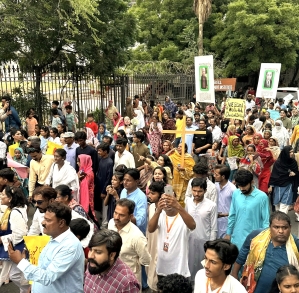
For the fifth consecutive year, Pakistan has retained its place near the bottom of the Henley Passport Index — a ranking that measures the freedom of movement a nation’s citizens enjoy.
The 2025 index, released last month, places Pakistan 103rd out of 106 countries, tied with Yemen and just above Iraq, Syria, and Afghanistan. Holders of the Pakistani passport can travel visa-free to a mere 33 destinations.
This dismal consistency has become a reflection not just of travel restrictions, but of something far deeper — a country’s reputation, reliability, and relevance on the global stage.
In an increasingly interconnected world where mobility signifies trust and stature, Pakistan’s green passport has come to represent the opposite: a steady descent into diplomatic and economic isolation.
The Henley Passport Index may seem like a simple chart of travel privileges, but in reality, it offers an unflinching mirror to the world’s power hierarchies.
Passports, after all, are not just travel documents — they are extensions of a state’s credibility.
The ease with which one can cross borders is directly tied to how much confidence the world places in that state’s governance, security systems, and stability.
On all these fronts, Pakistan’s decline has been slow, steady, and largely self-inflicted.
Each year, as the rankings are released, the reaction inside Pakistan follows a familiar pattern — a brief flurry of embarrassment, a few murmurs of protest on social media, and then silence.
Nothing changes, because nothing is meant to. The state’s institutions treat the index as a curiosity rather than a warning.
Successive governments have shown remarkable commitment to maintaining this inertia. In a global race for progress, Pakistan’s passport has managed to stay still — an accomplishment in its own right, if one values stagnation over advancement.
To understand why the Pakistani passport ranks where it does, one must look beyond the travel bans and visa denials.
The problem is rooted in perception, and perception is built on experience. Over the years, Pakistan’s image abroad has been shaped by headlines that speak of instability, extremism, and economic fragility.
From the collapse of foreign investment to the rise of militancy, from erratic foreign policies to bureaucratic inefficiency, every layer of dysfunction contributes to a loss of trust. The result is a passport that the world approaches with caution.
Visa-free access is not granted in isolation. It is earned through sustained diplomacy, economic partnerships, and a record of responsible governance.
It requires the world to believe that a traveller from a particular country poses no threat — economic, political, or security-related.
For Pakistan, that belief has eroded over decades. Even close allies in the Muslim world, who once offered open doors, have gradually tightened entry requirements.
Today, Pakistanis often face exhaustive scrutiny, interviews, and paperwork even for short visits, as embassies sift through layers of suspicion and bureaucratic red tape.
While Singaporeans can enter 193 countries without a visa, Pakistanis can access just 33 — and even that list reads like a roll call of diplomatic obscurity.
Many of the destinations are small island nations or states with limited global influence. For the average Pakistani, these places might as well be unreachable due to distance and cost.
The contrast with the rest of Asia is stark. Countries like India, Sri Lanka, Indonesia, and even Bangladesh have climbed steadily in the rankings, powered by consistent diplomatic engagement and internal reforms.
Pakistan, meanwhile, has remained trapped in its own inertia.
The weakness of a passport reflects more than foreign suspicion; it exposes domestic failure.
Each stamp of restriction is a silent indictment of how Pakistan manages its own affairs. It points to a state that has not inspired confidence in its ability to protect its citizens abroad, uphold agreements, or project stability. It reveals the cost of policies that prioritise short-term politics over long-term credibility.
When a nation’s own elite prefer to live, invest, and educate their children abroad, the passport they hold loses meaning. It becomes a symbol not of belonging, but of limitation.
This erosion of mobility also deepens the isolation of ordinary citizens. Travel is more than tourism; it is exposure to new ideas, education, and opportunity. When a country’s passport restricts access to the wider world, it inadvertently restricts its people’s ability to evolve.
For young Pakistanis, the world remains a distant promise — something glimpsed through screens rather than experienced in person. The barriers that separate them from international opportunity are not just consular; they are systemic.
The irony is hard to miss. Pakistan was once seen as a state with potential — strategically located, culturally vibrant, and rich in human capital.
Yet, decades of political turbulence and governance decay have reduced its global standing to a matter of suspicion.
The world’s response has been clear: tighter borders, stricter scrutiny, fewer privileges. Every visa rejection is a quiet reminder of how far the country has drifted from the respect it once commanded.
Diplomacy, too, plays its part. Where others invest in global relationships, Pakistan oscillates between alignment and alienation. Its foreign policy remains reactive, shaped more by crisis than by strategy.
International engagement is often transactional, not transformational. The result is a deficit of goodwill that no amount of rhetoric can repair. When trust erodes, mobility follows — and the passport becomes collateral damage.
Even the symbolism of the passport itself — green, meant to evoke identity and faith — now carries unintended irony.
For millions of Pakistanis abroad, it is a document that invites extra scrutiny at airports, secondary checks at immigration counters, and sceptical glances from officials.
For those who carry it, travel becomes an exercise in endurance, not freedom.
The Henley ranking, then, is not merely a chart; it is a diagnosis. It exposes the cumulative effects of weak governance, inconsistent diplomacy, and an economy that perpetually teeters on the edge.
It shows how international respect is earned — not demanded — and how every lost year compounds the challenge of recovery. While other nations quietly build trust and expand influence, Pakistan clings to a reputation that limits its reach.
Five years of stagnation in global passport rankings should have triggered introspection. Instead, they have become routine.
The country has adjusted to mediocrity, learned to wear its failures as inevitabilities. The passport, once intended as a key to the world, now feels like a reminder of the walls closing in.
At the heart of this decline lies a simple truth: the strength of a passport is the strength of the state behind it. When institutions falter, when diplomacy weakens, when credibility erodes — the passport reflects that decay with brutal honesty. The world sees what the nation refuses to acknowledge. And so, for the fifth year in a row, Pakistan’s passport stands where it has long been — not as a document of pride, but as an emblem of lost promise.



